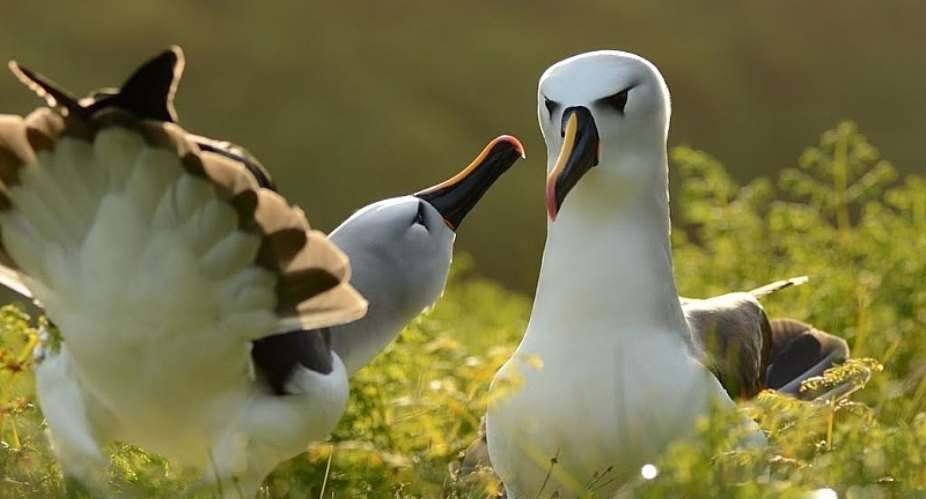Conservationists and fishermen in Namibia have reduced the accidental deaths of seabirds including endangered albatrosses, from up to 30,000 per year more than a decade ago, to just 215 at the last count: and it's all down to the simplest of bird scarers.
Namibia's fishing fleet searching for hake and horse mackerel along its 1,500 kilometre-long coastline was until recently considered among the most deadly in the world for seabirds.
Normally, when fishing boats put out their nets and and baited hooks, draw them in, or discard fishing waste -- they are a magnet for seabirds, many of which collide with the wrap cables drawn behind trawlers or get caught on the hooks of longline fishing boats.
But in 2015 Namibia adopted new regulations that require all hake fishing vessels to use bird-scaring lines, a sort of nautical scarecrow, and other measures to protect birds from fatal encounters with fishing gear.
The 98.4 percent reduction in seabird mortality between 2009-2018 is an “absolutely amazing” achievement, said Titus Shaanika, a member of the Albatross Task Force (ATF) based in Walvis Bay.
The bird-scaring lines consist of ropes festooned with colourful streamers attached to the back of the vessel. The benefits were most noticeable in the longline fishing fleet: boats that trail thousands of baited hooks on lines that stretch for up to 30 kilometres.
“Our estimate suggests that 215 seabirds were killed across this fleet in 2018 compared to 22,222 in 2009,” according to a new paper co-authored by Shaanika and published this month in the journal, Biological Conservation.
Apex predators
Shaanika, who works for the Namibia Nature Foundation, a conservation group that manages the work of the ATF in Namibia, said the fishing industry had actively co-operated with their members since 2008, allowing them onto their boats to collect data that were later used to convince the government to pass the new regulations.
“The fishing industry was instrumental in ensuring we achieved these results,” Shaanika told RFI.
Among seabirds to benefit will be Namibia's three main species of albatross, the shy, the black-browed and the endangered Atlantic yellow-nosed albatross.
Albatrosses, which can live up to the age of 60, reach sexual maturity late and only rear a single chick during the breeding season. Scientists say the death of an individual bird has a major impact on population growth rates.
Fifteen of the world's 22 species of albatross are threatened with extinction.
Shaanika said conserving them was critical, not just because “they are beautiful birds” that migrate vast distances to breeding sites on remote islands in the South Atlantic.
Ecosystem health
As apex predators they help to maintain healthy fish stocks and, ultimately, a robust fishing industry.
“By protecting albatrosses, we are ensuring our ocean ecosystems are healthy,” he said.
The decline in the deadly impact on seabirds caused by Namibian trawlers, as opposed to longline fishing vessels, wasn't as impressive: it was down to 1,452 seabirds in 2017 compared to 7,030 in 2009, the study in Conservation Biology says.
The authors found this was because many trawlers didn't deploy the bird-scaring lines until after the nets were already set, raising the risk of seabirds still colliding with the unprotected cables.
Nevertheless, the results achieved so far by the new regulations are extremely positive.
Shaanika said still more needs to be done to ensure it stays that way.
“The work needs to continue,” he said.





 Dumsor must stop vigil part 2: We’ll choose how we demonstrate and who to partne...
Dumsor must stop vigil part 2: We’ll choose how we demonstrate and who to partne...
 2024 elections: NDC stands on the side of morality, truth; NPP isn't an option —...
2024 elections: NDC stands on the side of morality, truth; NPP isn't an option —...
 Akufo-Addo has moved Ghana from 'Beyond Aid' to ‘Beyond Borrowing’ — Haruna Idri...
Akufo-Addo has moved Ghana from 'Beyond Aid' to ‘Beyond Borrowing’ — Haruna Idri...
 Train crash: NDC is full of evil mindset; driver who 'deliberately' parked the c...
Train crash: NDC is full of evil mindset; driver who 'deliberately' parked the c...
 Dumsor: Energy Minister must be fired; it’s becoming unbearable — IES
Dumsor: Energy Minister must be fired; it’s becoming unbearable — IES
 #DUMSORMUSTSTOP: IMANI responds to Yvonne Nelson's call for a joint vigil
#DUMSORMUSTSTOP: IMANI responds to Yvonne Nelson's call for a joint vigil
 'Obiara b3didi' — Manhyia South NPP Chairman fights for resourcing of NPP grassr...
'Obiara b3didi' — Manhyia South NPP Chairman fights for resourcing of NPP grassr...
 Dumsor: This thing is becoming unbecoming, collapsing our business — Nana Ofori ...
Dumsor: This thing is becoming unbecoming, collapsing our business — Nana Ofori ...
 Dumsor: It'll be no more by the end of April — Gideon Boako assure Ghanaians
Dumsor: It'll be no more by the end of April — Gideon Boako assure Ghanaians
 "I can now see clearly with my two eyes, thanks to the generosity of Afenyo-Mark...
"I can now see clearly with my two eyes, thanks to the generosity of Afenyo-Mark...
